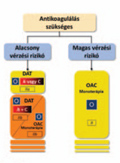The eLitMed.hu medical portal uses computer cookies for convenient operation. Detailed information can be found in the Cookie-policy.
Hypertension and nephrology - 2018;22(05)
Content
[The importance of recognition and proper treatment of hypertension and the maintenance of adherence in hypertension care]
[Hypertension is the leading cause of death and disability-adjusted life years. In the United States hypertension accounts for more cardiovascular (CV) deaths than any other modifiable CV disease risk factor and was second only to cigarette smoking as a preventable cause of death for any reason. In our country the situation is similar. In Hungary the number of subjects with hypertension is approximately 3.5 million and this high prevalence contributes markedly to the poor Hungarian CV morbidity and mortality figures. The recognition of hypertension, the initiation of drug therapy and the long-term follow- up of the patients is mainly the task of primary care. Besides that it inheres high responsibility, this is also a grateful commitment, as hypertension in most of the cases can be treated properly with lifestyle-changes and medications leading to a marked decrease of CV complications, especially stroke. In our review article we would like to focus on the high prevalence of hypertension worldwide as well as in our country, the exact implementation of screening, the risk reduction potential of the proper treatment and the importance of the long-term maintenance of treatment adherence.]
[Hungarian Vasculitis Registry – results of the first five years]
[Launching the Hungarian Vasculitis Registry aimed to collect information about prevalence and outcome of our patients with ANCA-associated vasculitis, and treatment protocols of the disease. The on-line data collection has been developing dynamically since its initiation five years ago, presently 278 patients’ files are available. Patients’ mean age is 58.2±14.5 years, 62% are women; their disease is associated with c-ANCA positivity in 51% and p-ANCA in 49%. At diagnosis GFR was 24.6±21.6 ml/min/1,73 m2, that time 29%, during the total follow up 39% of the registered subjects needed dialysis. Renal replacement therapy could be discontinued in 23% of them. In cases with focal histological changes, also with upper respiratory tract and skin involvement dialysis was significantly less frequently necessary, which underlines the importance of early diagnosis. In induction therapy steroid was administered for 94% of the patients, 85% of them got cyclophosphamide, 59% was treated by plasmapheresis, 11% got rituximab. Maintenance treat ment contained steroid in 80%, per os cyclophosphamide in 23%, parenteral cyclophosphamide in 22%, furthermore 40% of the patients got azathioprin, 8 subjects got mycophenolate and 6 got methotrexate. Median follow up was 30 months (IQR 6-78), during which period 20% of the patients died, 5% got kidney transplantation, and 5% were lost to follow up. Median survival was 14.8 years, five years survival was 85%, and ten years survival was 70%. Long term survival in patients with c-ANCA vasculitis seemed better comparing to p-ANCA vasculitis, but when correcting by age this difference disappeared. Predictors of death were age and dialysis dependent renal failure. Relapses developed in 27% of patients, 28% of them presented in the first year, 21% suffered it after five years of care. Collected data by the Hungarian Vasculitis Registry shows our society’s successful professional activity. Our results are comparable to the published data in the literature, yet there are several areas in our care where further improvements are warranted in order to increase our patient’s survival and quality of life.]
[The new European ESH/ESC guidelines - Part II. Therapy]
[The most important features of the new European joint hypertension guidelines of the European Society of Hypertension (ESH) and European Society of Cardiology became available as lectures at the ESH meeting in Barcelona, in 2018 June, while the publication came out in the Journal of Hypertension and also in the European Heart Journal in August, 2018. Based on the published new guidelines I summarise its most important therapeutic suggestions.]
[Hypertension and atrial fibrillation. Part 1. - Epidemiological data. The pathomechanism of PF in hypertension]
[Atrial fibrillation (PF) is the most common arrhythmia on the basis of analyzes conducted in different regions of the world. The main reason for this is the aging of the population. High blood pressure is one of the major factors of mortality in both developed and poor economical countries. The combined presence of the two diseases presents many hazards to our body. The most significant of these is the development of thromboembolic stroke, which is constantly increasing with age. The author analyzes in detail the aetiology called atrial cardiomyopathy, behind which there are complex structural, architectural, contractile and electro-physiological changes and leads to clinical manifestation of PF.]
[The actual aspects of the medical therapy of PAD patients after endovascular intervention. Through the eyes of an angiologist]
[After endovascular intervention in PAD the optimal medical therapy is essential for improving the patency and the quality of life as well as the cardiovascular risk reduction. According to the current guidelines the author gives an overview of the routine therapy and the possible advantages of longtermuse of cilostazol for these patients.]
1.
Clinical Neuroscience
Is there any difference in mortality rates of atrial fibrillation detected before or after ischemic stroke?2.
Clinical Neuroscience
Factors influencing the level of stigma in Parkinson’s disease in western Turkey3.
Clinical Neuroscience
[The effects of demographic and clinical factors on the severity of poststroke aphasia]4.
Clinical Neuroscience
Neuropathic pain and mood disorders in earthquake survivors with peripheral nerve injuries5.
Journal of Nursing Theory and Practice
[Correlations of Sarcopenia, Frailty, Falls and Social Isolation – A Literature Review in the Light of Swedish Statistics]1.
2.
3.
4.
Clinical Oncology
[Pathological classification of cholangiocarcinomas and their possible molecular targets]5.




